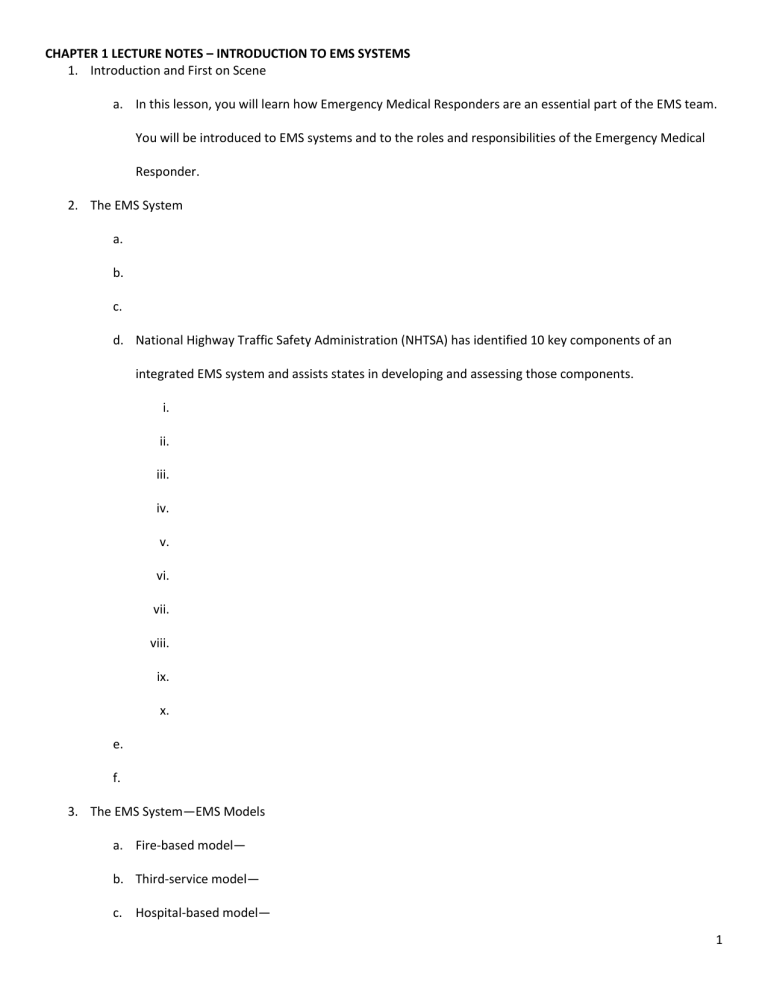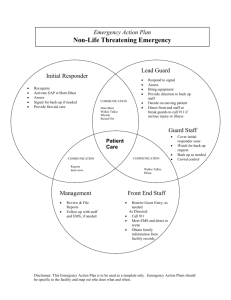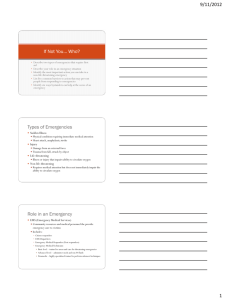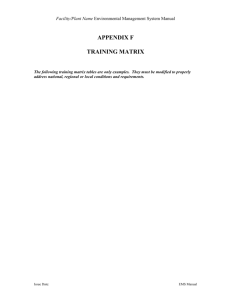CHAPTER 1 LECTURE NOTES – INTRODUCTION TO EMS

CHAPTER 1 LECTURE NOTES – INTRODUCTION TO EMS SYSTEMS
1.
Introduction and First on Scene a.
In this lesson, you will learn how Emergency Medical Responders are an essential part of the EMS team.
You will be introduced to EMS systems and to the roles and responsibilities of the Emergency Medical
Responder.
2.
The EMS System a.
b.
c.
d.
National Highway Traffic Safety Administration (NHTSA) has identified 10 key components of an integrated EMS system and assists states in developing and assessing those components. i.
ii.
iii.
iv.
v.
vi.
vii.
viii.
ix.
x.
e.
f.
3.
The EMS System—EMS Models a.
Fire-based model— b.
Third-service model— c.
Hospital-based model—
1
CHAPTER 1 LECTURE NOTES – INTRODUCTION TO EMS SYSTEMS
4.
The EMS System—Scope of Practice a.
Identifies b.
Often defined by
5.
The EMS System—Activating the EMS System a.
Most citizens activate the EMS system with a b.
c.
6.
The EMS System—In-Hospital Care System a.
Most patients are taken to a b.
7.
The EMS System—Medical Direction a.
Each EMS system has a Medical Director: b.
c.
8.
The Emergency Medical Responder a.
The Emergency Medical Responder is trained to i.
ii.
iii.
iv.
9.
The Emergency Medical Responder—Roles and Responsibilities a.
Personal safety i.
Your primary concern
2
CHAPTER 1 LECTURE NOTES – INTRODUCTION TO EMS SYSTEMS b.
Patient-related duties i.
Six main patient-related duties
1.
2.
3.
4.
5.
6.
10.
The Emergency Medical Responder—Traits a.
Work hard and study b.
Work well with people c.
Accept and respect others d.
Be honest and realistic e.
Control your feelings and comments at the emergency scene f.
Resolve the stress and emotional challenges caused by responding to emergencies g.
Maintain a neat and clean appearance h.
Approach and treat the patient respectfully
11.
The Emergency Medical Responder—Skills a.
b.
c.
12.
The Emergency Medical Responder—Equipment, Tools, and Supplies a.
Most Emergency Medical Responders carry b.
Some may carry specialized kits for trauma emergencies, medical emergencies, and childbirth. c.
d.
3
CHAPTER 1 LECTURE NOTES – INTRODUCTION TO EMS SYSTEMS
13.
The Emergency Medical Responder—Continuous Quality Improvement a.
b.
c.
14.
The Role of the Public Health System a.
b.
c.
15.
Disaster Assistance a.
b.
c.
16.
The Role of Research in EMS a.
b.
17.
Advances in Technology a.
b.
18.
Define the following terms: a.
Advanced Emergency Medical Technician: b.
Emergency Care: c.
Emergency Medical Dispatcher: d.
Emergency Medical Responder: e.
Emergency Medical Technician:
4






